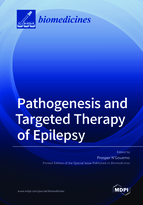Pathogenesis and Targeted Therapy of Epilepsy
A special issue of Biomedicines (ISSN 2227-9059). This special issue belongs to the section "Neurobiology and Clinical Neuroscience".
Deadline for manuscript submissions: closed (31 July 2022) | Viewed by 29469
Special Issue Editor
Interests: ion channels; calcium signaling; epilepsy; alcohol withdrawal seizures; prenatal alcohol exposure; substance abuse
Special Issues, Collections and Topics in MDPI journals
Special Issue Information
Dear Colleagues,
I am pleased to invite you to participate in this Special Issue, “Pathogenesis and Targeted Therapy of Epilepsy”.
Epilepsy is a disorder of neuronal hyperexcitability characterized by spontaneous and recurrent seizures. Despite the substantial number of antiepileptic drugs available to treat this debilitating neurological condition, approximately 30% of patients developed therapy-resistant epilepsy to the current pharmacological treatments. Thus, there is an urgent need to develop new therapeutic approaches based on novel mechanisms of the pathogenesis of seizures. Voltage-gated ion channels and their related signaling play important roles in controlling neuronal hyperexcitability that leads to seizures and therefore is considered as potential molecular targets for the treatment of seizures and epilepsies.
This Special Issue seeks papers providing new insights into the roles of voltage-gated and ligand-gated ion channels and their related signaling in the pathogenesis and pathophysiology of epileptogenesis, acquired epilepsy, and inherited epilepsy.
Dr. Prosper N'Gouemo
Guest Editor
Manuscript Submission Information
Manuscripts should be submitted online at www.mdpi.com by registering and logging in to this website. Once you are registered, click here to go to the submission form. Manuscripts can be submitted until the deadline. All submissions that pass pre-check are peer-reviewed. Accepted papers will be published continuously in the journal (as soon as accepted) and will be listed together on the special issue website. Research articles, review articles as well as short communications are invited. For planned papers, a title and short abstract (about 100 words) can be sent to the Editorial Office for announcement on this website.
Submitted manuscripts should not have been published previously, nor be under consideration for publication elsewhere (except conference proceedings papers). All manuscripts are thoroughly refereed through a single-blind peer-review process. A guide for authors and other relevant information for submission of manuscripts is available on the Instructions for Authors page. Biomedicines is an international peer-reviewed open access monthly journal published by MDPI.
Please visit the Instructions for Authors page before submitting a manuscript. The Article Processing Charge (APC) for publication in this open access journal is 2600 CHF (Swiss Francs). Submitted papers should be well formatted and use good English. Authors may use MDPI's English editing service prior to publication or during author revisions.
Keywords
- epileptogenesis
- seizures
- inherited epilepsy
- acquired epilepsy
- voltage-gated ion channels
- ligand-gated ion channels







